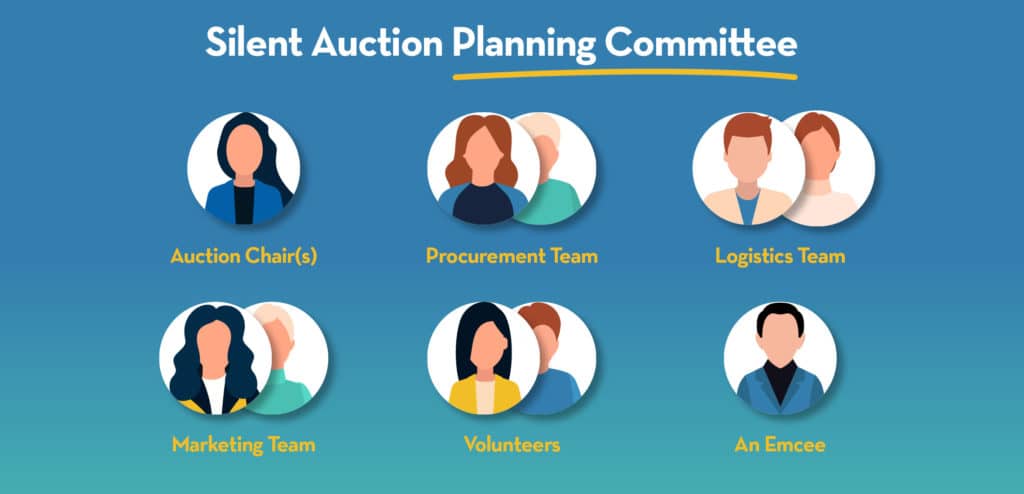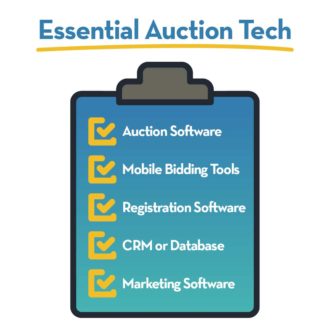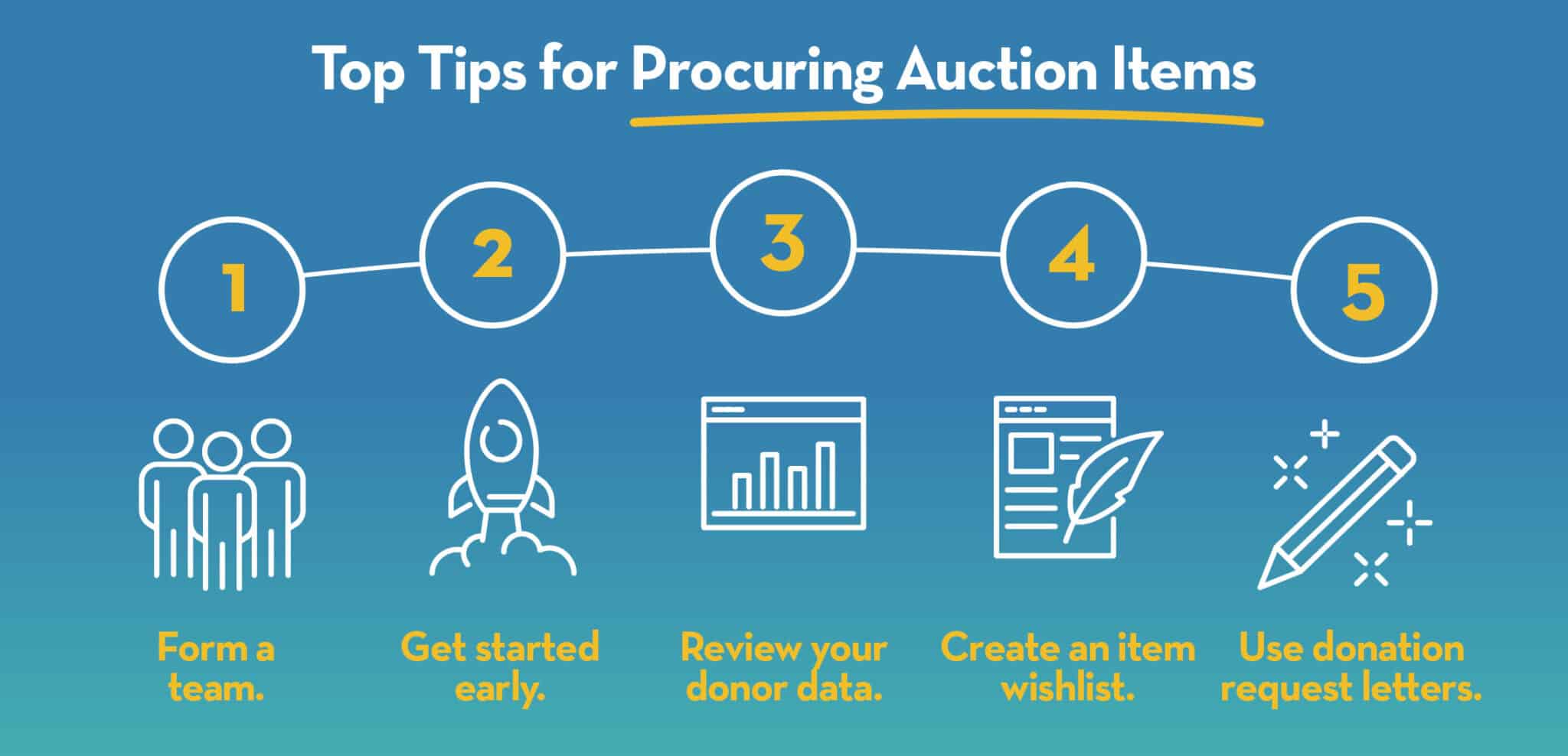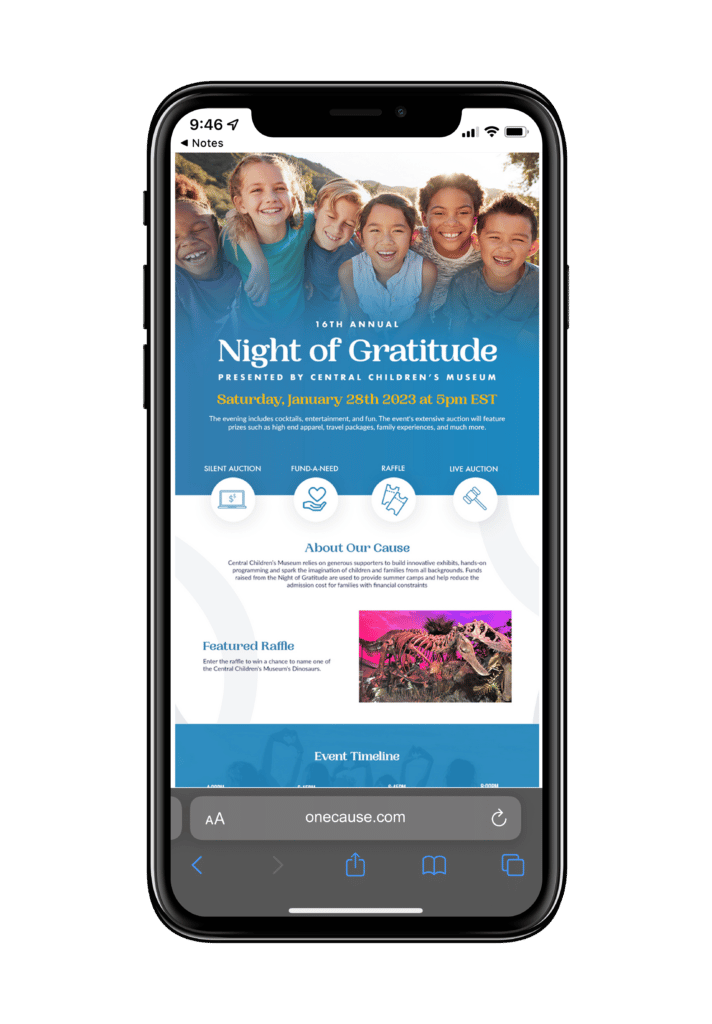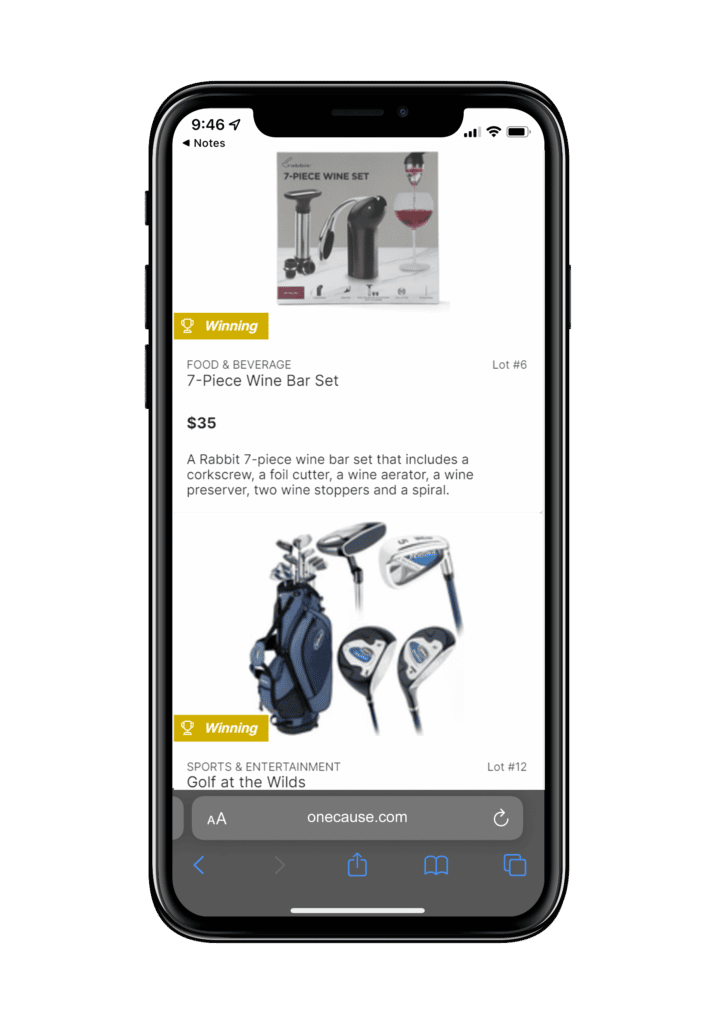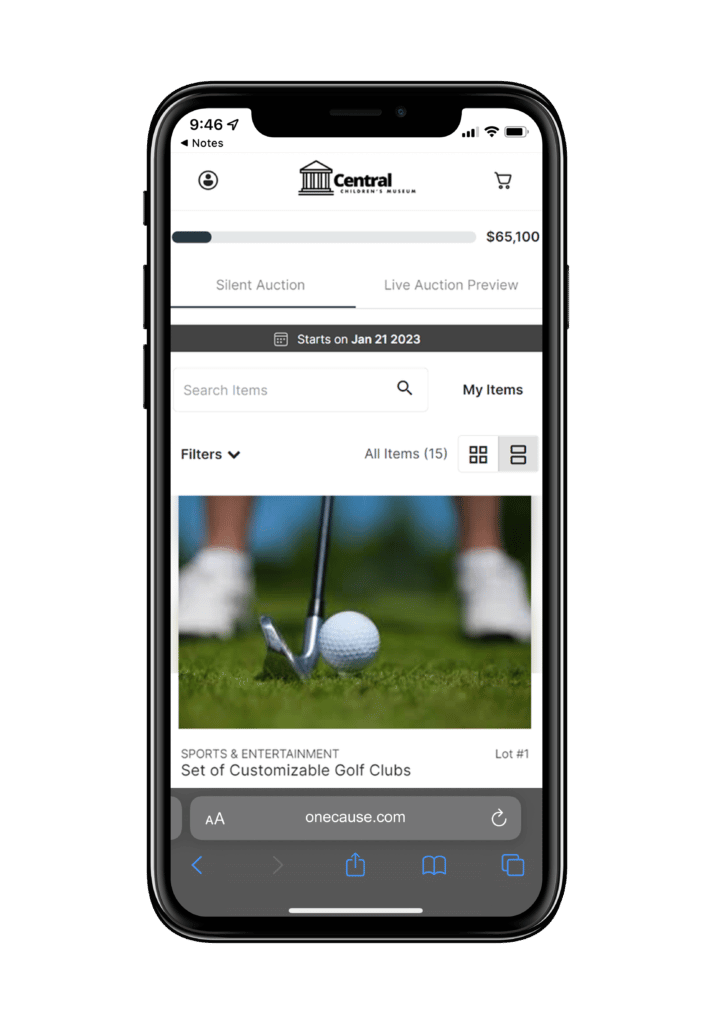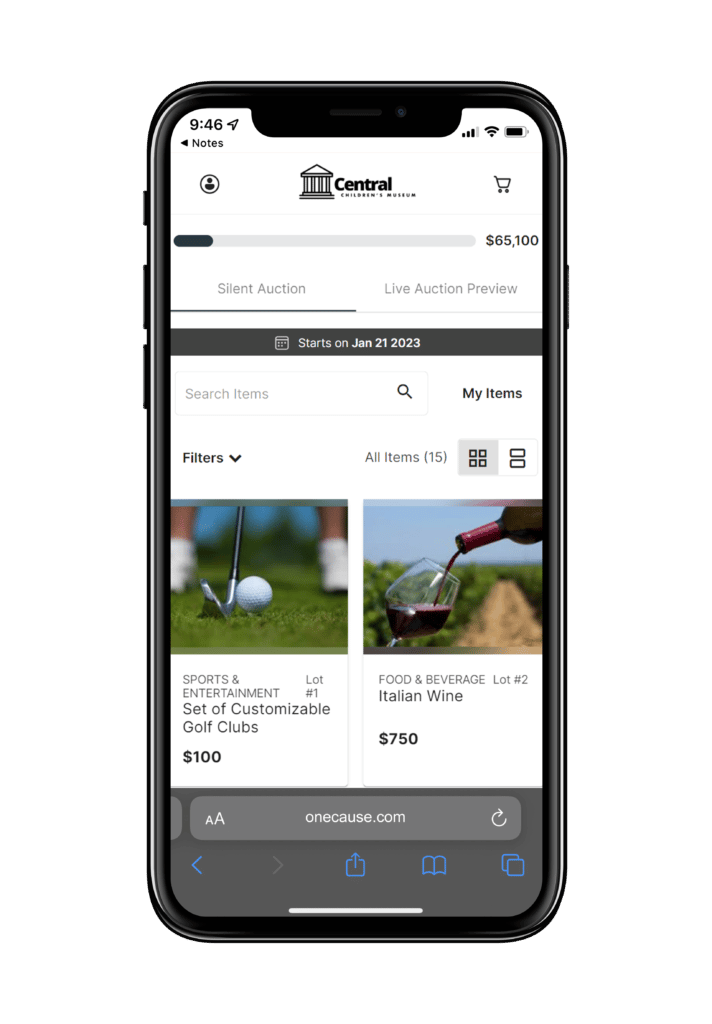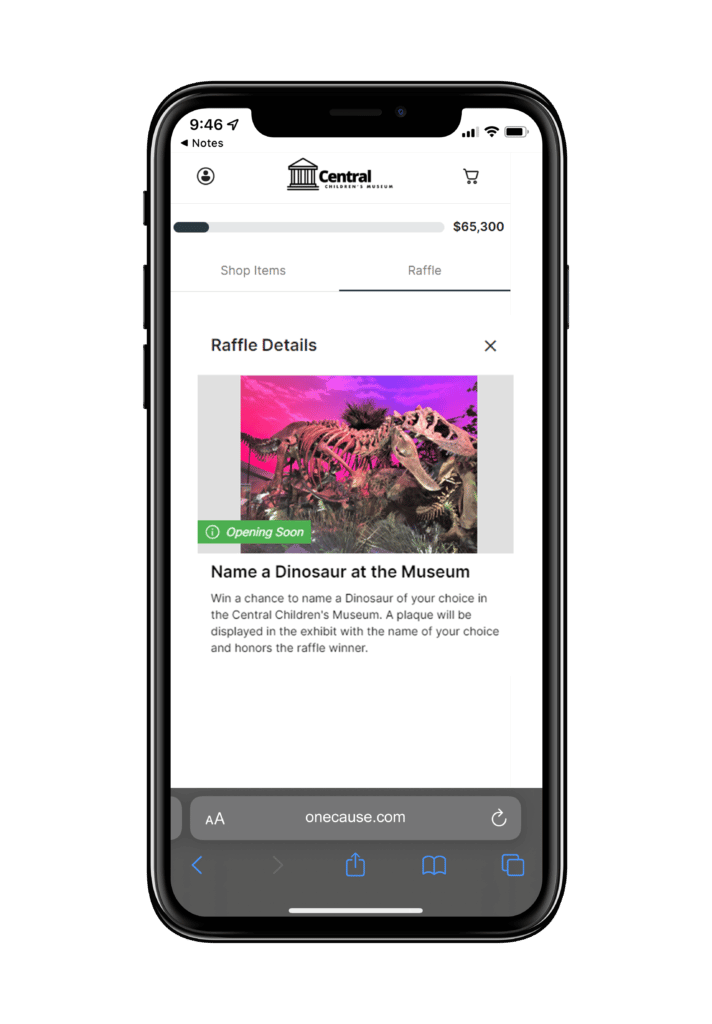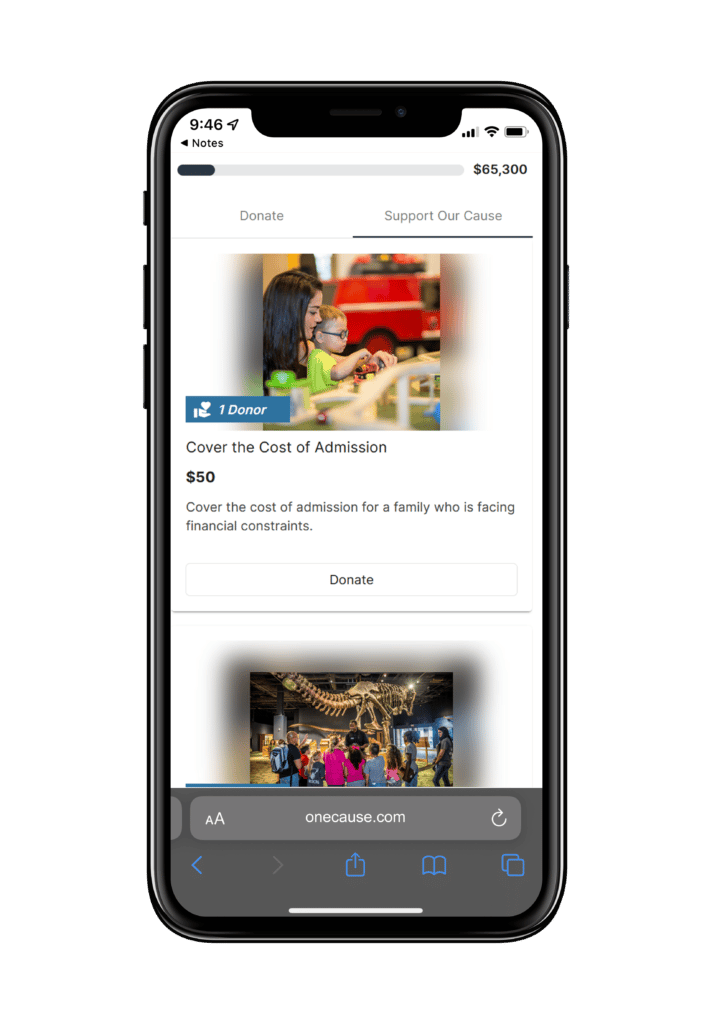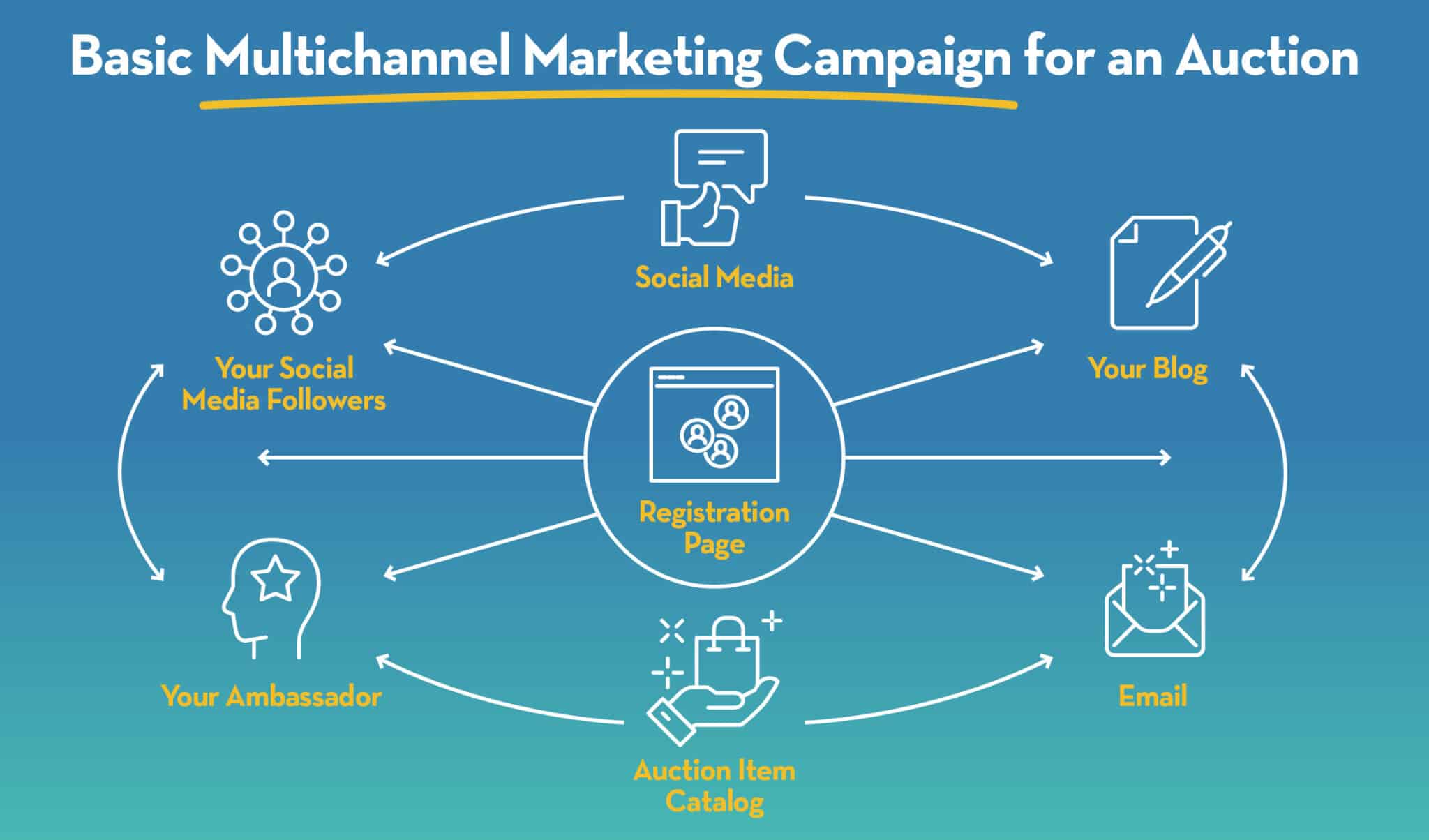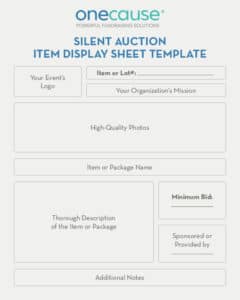How to Plan a Silent Auction: The Ultimate Guide for Success
If your nonprofit is looking for a fun and exciting event to host and raise money for your cause, you have many options at your fingertips: organized events, tournaments, peer-to-peer social fundraisers, year-round online giving, and one of the most popular and topic of this guide — silent auctions.
Silent auction events present an incredible opportunity to showcase your cause and bring together those who care about your mission. However, silent auctions do require planning and careful strategy to generate revenue for your cause. If you’re planning a charity auction for the first time or looking to breathe new life into your existing silent auction strategy, we’ve got you covered.
By the time you’ve read through our ultimate guide for how to plan a silent auction, you’ll be on track to creating the perfect event that will raise funds, drive deeper engagement, and further your mission.
What is a silent auction?
A silent auction is a classic fundraising event in which guests place bids on items you’ve procured. But, unlike live auctions, there is no auctioneer running the show. Bidders browse, bid on, and compete to win their favorite silent auction items and packages using mobile bidding or fundraising software. When time’s up, the highest bid wins the item, and your organization receives the proceeds.
Silent auctions are extremely engaging for guests and can be adapted for all types of audiences – in-person, virtual, or hybrid. They can also be easily added to larger events, like live auctions, galas, golf outings, and banquets.
Let’s review how to plan a silent auction and all the pro tips you’ll need to succeed.
How to Plan a Silent Auction: 10 Steps
Use the table above to jump to a particular section, or dive in from the top. First, we’ll cover a few common questions about these events. You’ll be raising more with your silent auction in no time.
Silent Auctions: Frequently Asked Questions
| Question | Answer |
|---|---|
| Who can host silent auctions? | Organizations of all types and sizes can succeed with silent auctions, including nonprofits, schools, community organizations, and more. Explore our success stories for real-life examples. |
| Should silent auctions be held as standalone events or as part of larger events? | Silent auctions are most commonly held alongside a larger gala or live auction. This strategy can boost the entire event's energy and engagement when planned well. However, your silent auction could be the main attraction of a smaller banquet or party-style event. |
| Can a silent auction be held virtually? | Yes! Online auctions are run very similarly to silent auctions. The main difference is the virtual setting and a longer timeframe. Learn more with our guide to online auctions. |
| How many items should I procure for my silent auction? | A good rule of thumb is to provide 1 or 2 auction items for every bidder or spender at your event. For a guest list of 100 people (roughly 50 couples who'll be bidding and spending together), approximately 25-35 items would create an effective market that's competitive but not overwhelming. |
| How do I procure the right items for my silent auction? | We'll cover item procurement tips in a section below. To get started, try reviewing your donor data to learn as much as you can about your bidders' interests and average donation amounts. |
| Are auction bids tax-deductible? | Yes, the IRS has specific guidance around any amounts paid over the fair market price that you establish for each item. Review our guide to pricing auction items to learn more. |
Step 1: Set Guidelines and Goals for Your Silent Auction.
As with any type of fundraising event or campaign, establishing guidelines and goals before diving into specifics will be valuable in the long run. Having a clear picture of your silent auction’s constraints, necessities, and goals will keep everyone on the same page. It also gives you a way to check in on your progress and course-correct as needed. Be sure to:
- Set your fundraising goal early in the planning process. It’s important to quantify exactly how much revenue you want to bring in, as this will inform much of your planning strategy and help you determine your budget.
- Break out revenue goals by event area (e.g., silent auctions, donation appeal, live auction, fixed price). This ensures you and your team know exactly what you need to raise at all stages of the fundraising journey.
Silent Auction
Guidelines
Your event’s guidelines include the logistical specifics that you’ll need to build your strategy around. These might include:
- A date or potential date range
- The context of your silent auction
- Will it be part of a larger event? If so, when is that event scheduled?
- A budget for your silent auction
- A venue or list of potential venues for the event
- Or will your silent auction take place virtually?
- The approximate number of attendees
- The amount of time you’ll need for the planning process
Silent Auction
Goals
Determining specific goals for your silent auction early in the planning process is essential. It’ll help you keep your eye on the prize! Typical goals related to silent auctions include:
- Targeting a concrete revenue goal
- Securing a number of new attendees or donors
- Retaining a percentage of past attendees
- Hitting particular online engagement targets
- Receiving a specific number of in-kind donations during item procurement
- Forming a number of a new corporate partnerships
Reviewing your past event and campaign data is the best way to shape your silent auction’s goals. What’s your average donation amount? How much do your events typically raise? How many of your supporters frequently attend events? Use these insights to set ambitious, yet achievable goals.
Most importantly, get started planning your auction early. Understanding your guidelines and goals now will give you a leg up during lengthy, intensive steps like item procurement. For school auctions, for example, we recommend getting started with procurement up to 10 months before the event.
Auction Planning Resources to Learn More
- Guide: Event Day Survival Kit for Nonprofits. This guide serves as a step-by-step guide for planning a flawless event and includes best practices to power your fundraising.
- Webinar: How to use Data and Segmentation to Retain More Donors. Learn how to refine your data strategies to build stronger relationships and increase donor retention.
- eBook: Leveraging Analytics to Create and Measure Success with the OneCause Fundraising Platform. New to using data to measure the performance of your events? Download this eBook to get started.
Step 2: Form a silent auction planning team.
Auctions can be fairly complex fundraising events, regardless of their exact size or scope. That’s why it’s rarely a good idea to try to tackle everything on your own. Instead, form a silent auction planning committee comprised of these members:
- Auction chair(s). One or two leaders to direct the event from pre-planning to closeout. They are the organizers who will make sure everything’s planned to a tee and runs a seamlessly as possible.
- Procurement team. Several staff members or volunteers to take charge of item procurement. This group’s only job is to solicit high-value, highly sought after auction items.
- Logistics team. One or more team members to handle event logistics. These diligent, organized individuals will handle things like the venue and ticketing process.
- Marketing team. One or more team members to lead promoting your event to supporters. They will handle creating the making plan and sourcing any promotional materials needed.
- Volunteers. These supporters will help with event setup, check-in, check-out, and item management. This group of all-hands-on-deck volunteers will be key to pulling off your silent auction.
- An emcee. An outgoing individual (either hired or a volunteer) to manage the flow of the event. Because this role is critical to the event, it may be worth hiring a professional.
Additionally, you might want to recruit volunteer ambassadors or social fundraisers to support your marketing efforts. We’ll cover this tactic in Step 8 below.
Of course, there may be some overlap between each of these teams depending on the size of your organization. The main idea is to clearly separate and delegate these crucial tasks. This will ensure nothing falls through the cracks as your event comes together.
Auction Planning Resources to Learn More:
- Success Story: Making Memories. Learn how this organization created engaging event experiences with the OneCause Fundraising Platform.
- Webinar: Perfecting Your Event Strategy. Dive into these top tips for how to maximize giving before, during, and after your event.
- Guide: Ambassador Fundraising Success. Want to learn more about volunteer ambassadors now? Start with this guide.
Step 3: Build a Silent Auction Toolkit
According to the 2023 Giving Experience Study, 63% of social donors consider ease of giving the most important factor when it comes to attending an event. That’s why having a fundraising platform that makes giving easy, intuitive, and seamless is imperative.
Take a look at your organization’s fundraising software early in the silent auction planning process. If you identify any gaps or potential improvements, you’ll need time to find and implement new solutions. While not every event will require a comprehensive toolkit of advanced software, there are a few foundational tools that we recommend:
- Dedicated auction software to plan and manage the event from beginning to end.
- Mobile bidding tools, which boosts engagement and bids during the event.
- Registration software, ideally included in your larger auction event platform.
- A CRM or other database to store the data generated by your auction.
- Marketing software, especially for social media and email.
Mobile bidding, in particular, can be a game-changer for silent auctions. By making it easier and faster to bid, you can drastically increase engagement and improve your guests’ experience. Plus, these tools make it easy to get your announcements and updates directly to bidders as needed.
For a more thorough overview of what to look for in your auction software, check out our Complete Buyers Guide to Nonprofit Fundraising Software.
Step 4: Begin procuring silent auction items.
A silent auction can only be as successful as the quality of its auction items. Priceless and engaging items excite your audience and raise more proceeds to fuel your mission.
There isn’t a magical list of items that guarantee to sell best, but we can help point you in the right direction. For any type of auction, we recommend a few procurement best practices:
- Form a procurement team. As mentioned above, delegating procurement to a team of individuals will be your best bet. Procurement can be a lengthy process, so sharing the workload is a good idea.
- Get started early. Since item procurement can take a while, you’ll need plenty of time to refine your strategy, identify the perfect items, and find potential donors.
- Review your donor data. Use your data to better understand what will best motivate your bidders. What are their interests? How much do they typically donate? This will boost your chances of success.
- Create an item wishlist. Before reaching out to potential item donors, work with your team to create a procurement wishlist. A concrete battle-plan will make the process easier to manage.
- Find corporate sponsors. Identify, reach out to, and leverage corporate sponsors’ support to ease the financial burden of procuring auction items. Start by contacting local businesses that share similar values and create a corporate sponsorship proposal that will benefit both parties.
- Use donation request letters. When reaching out to potential item donors and sponsors, streamline your efforts by making template donation request letters. This will simplify the process for any team members who are new to item procurement.
For more procurement insights and a comprehensive list of items to help kickstart your wishlist, explore our complete guide to charity auction item ideas.
Pro Tip! Remember that guests attend your silent auction for a fun night out. Your procurement strategy must prioritize engaging and exciting items.
Of course you should tailor your items to the interests of your particular supporters, but exciting items will always perform better than mundane ones. Experiences, technology, and interesting baskets of packaged items will most likely receive more bids than home goods or coupons for free services.
If a potential donor offers an item or package that doesn’t quite fit your procurement strategy, don’t worry. Instead, try asking for the item’s cash value as a donation that can be used for a different, more relevant item. Or, offer them recognition as an event sponsor in exchange for financial support.
Silent Auction Procurement Resources to Learn More:
- Guide: Silent Auction Packaging and Procurement Tips. For more tips on how to procure and bundle your items, explore this guide.
- Webinar: How to Attract New Companies to Your Cause. Large and small businesses make excellent partners during the procurement stage. Use this webinar to learn more.
- Guide: Save Time and Procure Better Items. Use these tips to streamline your silent auction procurement process like the pros!
Step 5: Pricing Your Silent Auction Items and Creating a Catalog
Properly pricing the silent auction items that you procure is essential to maximize revenue. However, it’s a step that too many organizations neglect.
How you price your auction items will have a direct impact on the success of your silent auction. Price items too high and you’ll reduce bids, but price items too low and you’ll risk not driving a positive ROI for your event.
For a complete walkthrough of the process, read our guide to pricing silent auction items. If you’re short on time, here are the essentials:
- Establishing a correct fair market value (or FMV) for each item is critical. For tangible items and travel packages, use their retail values. For intangible items, like unique experiences, make an educated guess based on what you know about your donors and insights from peers in other organizations or dedicated supporters.
- For bidders, any amount paid over an item’s FMV is tax-deductible. Clearly labeling the item’s FMV in your item catalog is an essential courtesy.
- Set each item’s starting bid at around 30-50% of its FMV. Adjust as needed depending on the specific context of your auction, but this range is a safe bet.
- Set standard bid increments at 10-15% of each item’s FMV. Increments can be automatically displayed for bidders with mobile bidding software.
- Offer a buy-it-now option for some items at 150-200% of their FMV. Don’t use this strategy for your most unique, exciting, or high-value items.
Pro Tip! Price your items as you procure them. This will help you avoid being faced with the sudden task of pricing everything at once. If you’re working with dedicated auction software, it’s easy to record your pricing details as you go and store them all in one place.
Building your auction item catalog is also greatly simplified with the help of auction software. Create an organized catalog to promote your items and share essential details. Each catalog entry should include points like:
- The name/title of the item and its lot number
- A thorough description
- A complete list of contents, if it’s a package
- The item’s fair market value
- The item’s starting bid and bidding increment
- The sponsor or donor who provided the item, if applicable
Today, providing an online, mobile-optimized silent auction item catalog is crucial. This is especially true if guests will be using mobile bidding software during the event. Plus, an online item catalog opens up your in-person silent auctions to virtual attendees!
Check out these example screenshots to see a mobile item catalog in auction.
You’ll also need organized records of each item’s pricing information and other details to create your item display sheets later. Jump ahead to check out our display sheet template.
Step 6: Plan your silent auction’s logistics.
Around the same time or shortly after beginning the procurement process, other team members should turn their attention to planning your silent auction’s logistics, including:
- Securing a venue (or setting up your auction’s website if being held virtually).
- Planning additional activities, like wine pulls, raffles, and entertainment.
- Preparing your food or catering plans for the gala or event.
Additionally, you’ll need to start thinking about the bidding experience and flow of the event’s activities. Ask yourself these questions:
- How will supporters register for your event?
- We’ll cover event registration in the next step.
- How will attendees check into the silent auction?
- Make sure you have hardware (like a tablet) that can save payment information in person.
- How will attendees check-out and collect their won items?
- Pre-registered payment information greatly streamlines this process.
- How long will the silent auction last?
- Around three hours is an average duration.
- If occurring during a larger event, like a gala and live auction, where does your silent auction fit in?
- Avoid too much overlap between two revenue-generating activities. For instance, don’t close your silent auction during a live auction. This distraction will hurt engagement on both fronts.
- For virtual events, outline a timeline for the entire program.
- Who will provide instructions, commentary, and announcements?
- A hired or volunteer emcee with a wireless mic is a smart move.
- Mobile bidding software also allows you to send push notifications to bidders.
Although this may seem like an overwhelming list of specifics to decide on, getting started early will give you plenty of time to decide and adjust your strategies. The most important thing is to consider them now, as scrambling on the day of your silent auction can have serious negative effects.
Silent Auction Planning Resources to Learn More
- Webinar: The Power of the Platform. Learn how the all new OneCause Fundraising Platform can help streamline your auction planning process from start to finish.
- Success Story: 50 Legs. Read about how the OneCause Fundraising Platform created the perfect check-in experience for the 50 Legs organization and their guests.
- Guide: Silent Auction Checkout Tips for Speed and Success. Use our pro tips to streamline your silent auction checkout and ensure guests leave as happy as they arrived.
Step 7: Set up an event registration page for your silent auction.
How guests register for your silent auction will be their first interaction with your event, so you need to make a great impression!
Today, an online registration page is always the best move to easily share your event with a large audience. If you’re using dedicated software to plan and manage your silent auction event, features to create your event website and item catalog should come included. There are a number of ways to make the most of the silent auction registration process. Ask yourself these questions:
- What information do we need and want from registrants?
- Contact information is always essential, as are ticket fees if your silent auction event is ticketed.
- Are there any other data points that would be helpful for your strategy? For example, how did registrants hear about your silent auction?
- Will we offer any ticket packages?
- Early bird specials or VIP packages could include perks like reduced fees or early access to mobile bidding.
- Fundraising add-ons like merchandise, raffle tickets, or penny social tickets could also be incorporated into the registration process.
- How will we handle in-person registration?
- The OneCause Fundraising Platform offers contactless check-in and QR codes for event guests, making it easy for your team to get guests into the event, learning about your mission, and donating to your cause.
- Are there other event logistics to consider?
- For events where food will be served, be sure your form provides a section for guests to specify any requests or restrictions.
Additionally, ensure your registration page is fully mobile-optimized. A clunky form that doesn’t work on smartphones is much more likely to cause potential attendees to give up in frustration or forget about your event.
Check out our guide to online event registration for more best practices and software features to look out for.
Silent Auction Planning Resources to Learn More
- Blog: Secrets to Optimizing Check-in. The check-in process can be greatly improved and streamlined through smarter registration strategies.
- Guide: Planning a Fundraising Event. For an overview of general steps for any type of event, including the ticketing process, save this guide.
- Guide: How to Engage Donors Before, During, and After Your Event. Learn how the OneCause Fundraising Platform delivers a seamless giving experience for your supporters, while making fundraising flexible and less burdensome for your nonprofit.
Step 8: Start promoting your silent auction.
With most of your items procured, an item catalog set up, and logistics coming together, now’s the time to start spreading the word! Marketing your event will get bidders in the door and ensure you can generate the revenue needed to hit your goals.
We cover this topic in-depth in our complete charity auction guide. To recap, one effective marketing strategy we recommend is creating a multi-channel campaign to promote your silent auction:
The underlying idea with this type of marketing strategy is to use each of your digital outlets to generate more attention and steer potential attendees to your registration page. Typical nonprofit marketing outlets include:
- Your social media profiles
- The blog on your organization’s website
- Your online auction item catalog
- Volunteer ambassadors
- Supporters’ social media
Create digital content to promote your auction, like announcements and sneak previews, and promote it across your digital outlets. Send email readers to your website to learn more, or link social media readers to your item catalog, for instance. Just be sure to include a direct link to your registration page to ensure maximum engagement.
Additionally, one marketing and fundraising strategy that we highly recommend is recruiting volunteer ambassadors. These well-connected and dedicated supporters will help to promote your silent auction to their own networks of friends, family, and colleagues. Set specific goals for registrations or donations, empower your ambassadors with training and materials, and reward them during your event with awards or prizes.
This strategy has proven extremely effective for many organizations, enabling them to reach much wider audiences and boost overall revenue. Ambassadors help you tap into social proof, which can be a powerful motivator to get newcomers engaged with your cause when provided by a friend or loved one.
Pro Tip! If you’re planning an online silent auction, don’t worry! Multi-channel marketing campaigns are perfect for promoting virtual fundraising events. Ambassador fundraising strategies can also be easily adapted to virtual settings.
Silent Auction Marketing Resources to Learn More:
- Success Story: Des Moines Christian School. Learn how this school rocketed past their engagement and revenue goals with ambassador fundraising techniques.
- Guide: Nonprofit Event Marketing. New to fundraising event promotion? Start with this overview to learn the essentials and orient your team.
- Guide: Creating a Marketing Plan. To learn how to create an engaging marketing plan that’s sure to help you reach and engage supporters, check out our ultimate guide.
Step 9: Create display sheets and a layout to streamline running your silent auction.
As all of the most essential pieces of your silent auction strategy begin coming together, there are a few more event logistics to consider.
When it’s time to run your silent auction, preparing a few plans in advance will be a big help for your team. Namely, prepare your auction item display sheets and a rough floor plan or layout several days or weeks before the event.
Silent Auction Item Display Sheets
These are the physical sheets that you use to display relevant information about each silent auction item. Auction item display sheets should contain all of the essential information that you determined earlier when pricing your items and creating a catalog.
Even if you’re using mobile bidding software to facilitate bids, guests still expect a visual display sheet. Display sheets make it easy for your supporters to quickly look up items in your online catalog, and it allows them to pause and really take their time browsing items!
Click on our silent auction display sheet template to save a larger version. Feel free to use this for your own silent auction!
Silent Auction Floor Plans or Layouts
If you already know what your silent auction space looks like (or, even better, have a floor plan with dimensions!), get started thinking about how you’ll arrange your items and tables. You don’t necessarily need to plan your layout down to the inch, but putting some strategy into your layout ahead of time will prevent a lot of second-guessing on the day of your auction. There are a few essentials to keep in mind:
- Every table needs to be easily accessible and visible.
- Think about the flow of foot traffic through the space.
- Avoid clumping tables in a way that might create “dead zones.”
- Also avoid placing tables in open areas where guests will naturally gather to chat (but not necessarily look at your items).
- Don’t crowd your items on too few tables.
- A jumbled appearance can overwhelm bidders and reduce engagement with those items.
- Consider the price ranges of your items.
- Adding a high- or mid-value item to a table of low-value items will depress its perceived value.
- Alternately, adding a mid- or low-value item to a table of more valuable items can actually make it appear more valuable.
- Create designated spaces to handle logistics.
- A check-in station, area to collect won items, and a check-out station will be essential.
Whenever you have the time, plan in advance! Preparing your display sheets and a rough layout will make everyone’s job easier when it’s time to start setting up.
Pro Tip! Even for virtual events, a strong display strategy and event timeline will be crucial. Despite not using a physical space, you still have to catch your bidders’ eyes and keep them engaged. Try configuring your item catalog to highlight featured items or creating custom pages just for your main attraction items. Use push notifications to draw more attention to items as needed and announce bidding wars.
Silent Auction Planning Resources to Learn More:
- Webinar: Secrets to Event Success. Perfect your guests’ experience with these secrets to success! It’s full of tips and tricks to increase and maximize giving.
- Guide: Tips For Setting the Stage for Your Auction. Learn how to strategically optimize your event venue with these 6 key steps.
- eBook: Innovative Fundraising Event Ideas. Use these tips and ideas to incorporate new, interesting, and engaging ideas into your event strategy.
Step 10: Prepare strategies to boost engagement at your silent auction.
Finally, it’s always a good idea to review your game plan and identify any ways to maximize bidder engagement during your silent auction. Be sure to:
- Utilize your emcee’s talents. With a wireless microphone, your emcee should stroll the event and call out special packages and deals. Directing attention to items that haven’t received many bids yet is never a bad idea. If one item is experiencing some very competitive bidding, raise the energy even higher by declaring a bidding war.
- Have your staff members and volunteer ambassadors actively mingle. This will help draw attention to auction items. An active, engaging event will always generate more bids than one where bidders are left on their own without direction.
- Tap into the power of mobile bidding. Mobile bidding tools are game-changers for silent auctions of all shapes and sizes for a few reasons.
- These tools make it easier and much faster for bidders to place bids.
- Attendees can track favorite items and get notified when they’ve been outbid.
- Push notifications make it easy to make special announcements.
- Your organization gets access to invaluable real-time and post-event engagement data.
The best way to boost engagement is to put the FUN in fundraising! Create an atmosphere that has energy and use a variety of communication strategies onsite to amp up the excitement.
Want to learn more about how to run your silent auction on the big day? Check out the second part of this guide for everything you need to know about pulling off an unforgettable silent auction experience!
Wrapping Up
Preparing for a silent auction can feel like a lot of work, but with the right strategies and support of your team, you’ll be in great shape to craft a winning plan. If you’re eager to learn more about how to run your silent auction effectively, take a look at these top resources:
- How to Run a Silent Auction: Head on over to our guide to running a silent auction for even more guidance on what to do on the day of your event.
- Mobile Bidding & Auction Software: Check out powerful solutions to push your fundraising forward.
- Charity Auction Planning Guide: As with any fundraising event, thorough planning plays an important role in guaranteeing a return on all the hard work and resources you’ve invested in your silent auction. Explore this ultimate guide to planning a charity auction of any type, whether it’s in-person, virtual, or hybrid.


